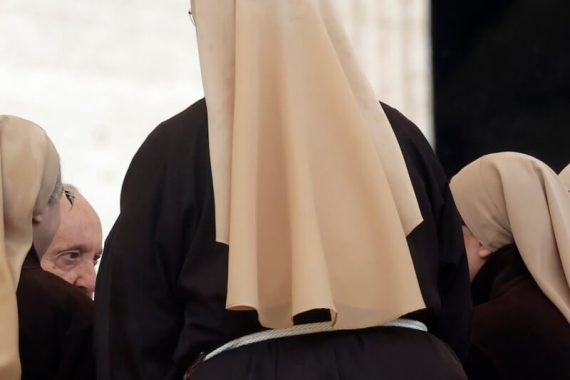T
he journey of the veil transcends time. From its depiction in French couture to a resurgence in 1990s fashion trends, the veil’s versatility continues unabated. Amidst ever-changing cultural norms, it remains a reflection of identity. From ancient Greece to the present day, the veil reflects the history of mankind.
The veil has a history going back thousands of years and is intricately woven into the cultural fabric of Europe. It is not only a sign of changing fashion, but also a reflection of women’s evolving roles, changing social norms, and religious ideologies. From ancient traditions to modern representations, the history of the veil offers a deep insight into the complexity of European history.
Its evolution from religious symbols to fashion statements reflects the changing currents of society. As Europe continues to evolve, the multilayered meaning of the veil remains. It serves as a tangible link to the past and a lens through which we view the complexity of our shared cultural heritage.
Roots beyond Christianity
Although Christianity played a crucial role in shaping the European veil tradition, the origins of the veil can be traced back to ancient cultures. In ancient Greece, the veil was a sign of respectability and high status. It distinguished women who were protected and women with loose morals. It was illegal for lower status women, such as slaves and prostitutes, to wear a veil, illustrating the role of the veil in the social hierarchy.
With the rise of the Roman Empire, the tradition of veiling took on a new dimension. Women wore the veil as a symbol of their marital bond. The veil became a strong symbol of the husband’s authority, which was emphasized by traditions such as the colorful bridal veil. The roots of this practice reached back to Roman matrons, the vestal virgins, and their particular veiling rituals.
Theological debates further defined the role of the veil. Tertullian’s On the Veling of Virgins emphasized the subjugation of women and spoke of a dangerous attraction that needed to be concealed. Clement of Alexandria echoed similar thoughts in his writings, emphasizing modesty as a reason for veiling. The Council of Gangres reinforced this idea and solidified veiling as a sign of submission.
The development of fashion in medieval Europe gave new meanings to the veil. Noblewomen veiled themselves with hoods and caps, embodying both fashion and humility. The Renaissance, characterized by elaborate headdresses and an evolving esthetic, influenced the development of the veil style. The Protestant Reformation challenged veiling and led to different practices in different denominations. For instance, in Anabaptism, it is believed that wearing a head covering aligned with Saint Paul’s teachings, making it obligatory to be worn continuously.
A scriptural beginning: Icons and sanctity
In the earliest pages of Christian scripture, in the Letter to the Corinthians, one can find statements that have resonated for centuries; 1 Corinthians 11 reads, “But every woman who prays or prophesies with her head uncovered dishonors her head—it is the same as having her head shaved. For if a woman does not cover her head, she might as well have her hair cut off; but if it is a disgrace for a woman to have her hair cut off or her head shaved, then she should cover her head.”
This initial significance flourished as church fathers such as Tertullian of Carthage and Clement of Alexandria articulated the importance of the veil and made it a symbol of religious piety. Tertullian suggests that not only children but also adult women should wear a veil in church, regardless of their marital status. Clement of Alexandria advises that women, as an additional consideration, should be fully covered unless they are in the privacy of their own homes. This clothing is considered dignified and serves to protect them from unwanted attention.
Throughout history, the influence of the veil has gone beyond theology. In church iconography, in frescoes and paintings, women were often depicted wearing veils. From the serene portrayal of saints to the dignified shroud enveloping Virgin Mary, the veil conveyed reverence and devotion. This connection was so profound that the veil remains an integral part of religious art today.
Transition to modernity: From tradition to accessory
The early 20th century marked a turning point for veiling traditions. The change was epitomized by the rise of “flapper” culture in the 1920s. Flappers were young women who rebelled against the social norms and expectations of the time. They wore short skirts, had bobs, and challenged traditional gender roles. They embraced a freer and more independent lifestyle, and often enjoyed jazz music, dancing, and socializing. This cultural movement symbolized a break with tradition and reflected the general social changes of the time.
Fast-forward to the 1960s and Europe was swept by another wave of cultural change. World War I and the social changes that followed set the stage for the so-called sexual revolution in the Western world. Traditional norms were challenged and the role of women began to change. The birth control pill and the increasing availability of contraceptives triggered the sexual revolution. Conventional notions regarding gender roles, relationships, and clothing norms were completely overturned. The veil, once a symbol of modesty and marital status, was relegated to the background.
Meanwhile, in the United States, the southern states cultivated a unique “church crown” culture inspired by biblical verses: hats, worn with strict etiquette, became a cultural emblem.
Even though veiling has become less common in everyday life in the Western world, it is still present. Mourning veils and religious practices preserve the solemnity of this tradition. The symbolism of the veil is also changing: from obedience to identity, it remains in various forms. In some Orthodox Christian countries, the veil is maintained in churches, while religious communities such as the Amish and Mennonites, maintain the tradition in everyday life.
The Amish branched off from Switzerland, Alsace, Germany, Russia, and Holland and they migrated to the US in the 19th and 20th centuries. In some parts of Europe, the tradition of women wearing a veil during religious practices is maintained. In Orthodox Christian countries, for example, veiling is still required in churches. In Catholic countries, such as Spain and Portugal, however, the custom has disappeared over time.
Continuing legacy and debates
The changing meaning of the veil reveals deeper social currents. Especially with the Muslim worker migration to Europe in the 1960s and the first half of the 1970s. Veiling practices have often been associated with male dominance and female subjugation, and interpreted as tools of patriarchal control. Mona Eltahawy and some contend that instead of symbolizing choice and devotion, the veil has, on occasion, been employed to oppress women’s autonomy and erode gender equality.
Moreover, current considerations about the veil have sparked controversial debates about cultural integration, religious freedom, and secularism. The presence of the veil in European societies has sometimes been questioned for its perceived deviation from secular values, with some voices calling for stricter regulations on its use in public.
From its ancient origins to its role in Christianity and fashion, the veil has reflected changing social norms and beliefs. It is a timeless symbol of evolution and continuity in the fabric of European tradition. In today’s world, where debates continue not only in European society but also on a global scale, the veil retains its complex status as a symbol of tradition, identity, and self-determination. While discussions and bans on the issue continue in global political discourse, people remain determined to preserve their deeply held beliefs.
Recommended





